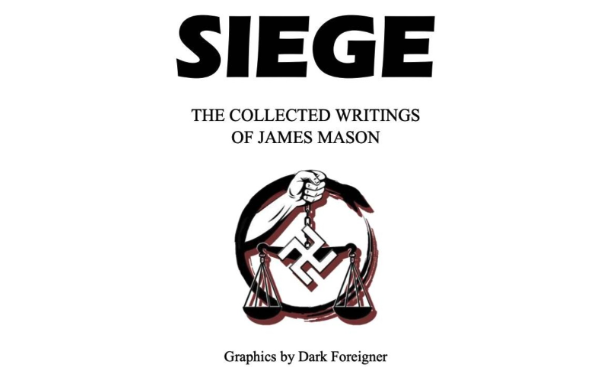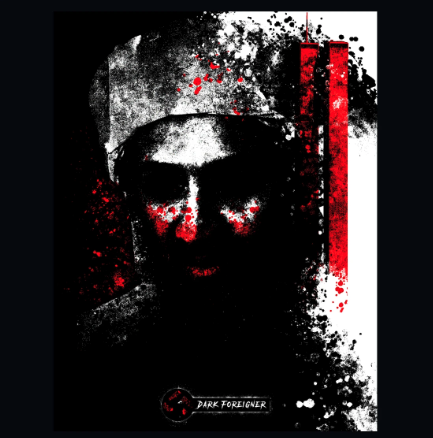Content Warning: this Insight contains images of neo-Nazi propaganda
Introduction
On 5 July 2023, the Royal Canadian Mounted Police (RCMP) arrested Patrick Gordon Macdonald, known in accelerationist circles by his digital alias, Dark Foreigner. Macdonald worked for years as a crucial neo-Nazi propagandist and played an instrumental role in crafting the visual aesthetic that, at one point, defined militant accelerationist networks like Atomwaffen Division, The Base, Sonnenkrieg Division, Feuerkrieg Division, and the Order of Nine Angles (O9A) offshoot, Tempel ov Blood. Macdonald’s infamous propaganda, designed to incite others to violence, amplified the preexisting violent narratives in militant accelerationist propaganda and bolstered recruitment efforts for less effective militant accelerationist networks. In essence, his contributions were a critical mechanism that made accelerationist recruitment and propaganda efforts more capable and sophisticated.
Macdonald’s arrest signals a clear change in how Canadian and Western law enforcement are approaching militant accelerationism; the RCMP stated that this “is the first [case] in Canada in which an individual advocating a violent far-right ideology has been charged with both terrorism and hate propaganda.” According to the RCMP, Macdonald “allegedly participated in and facilitated the creation, production and distribution of three terrorist propaganda videos”—material the RCMP claims “was intended to promote the group and recruit members, and encourages the commission of terrorist activities.” Dark Foreigner has long been a subject of focus and monitoring for researchers at the Accelerationism Research Consortium (ARC), and our findings support the allegations of criminal wrongdoing by the RCMP.
In 2021, VICE news reporters identified Dark Foreigner as Macdonald and articulated how he had become the “chief propagandist” for Atomwaffen Division, a listed terrorist organisation in Canada. At the peak of his popularity, his aesthetic style and hateful artwork became synonymous with the collective visual branding of militant accelerationism. Notably, the Dark Foreigner persona never hid its ideologically motivated activity, just the creator’s true identity. On a DeviantArt profile associated with Dark Foreigner, Macdonald posted the following message in 2018:
“This art project has gone from a simple past time to a full on obsession of mine, helping out groups like Siegeculture, Atomwaffen, and many others. This blog will have DAILY posts now, and nothing will stop the Dark Foreigner project. Stay posted for a whole new wave of killer content.
Let’s bring a new image of terror and dread, to the 21st century.
Hail Victory”
In the same post, Macdonald provided links to multiple social media accounts associated with Dark Foreigner. While the accounts are now defunct or banned, the wide range of platforms that he linked to is demonstrative of his desire to maximise his audience reach.
Macdonald reportedly got his start in militant accelerationism via the Iron March forum, where he first used the moniker ‘Dark Foreigner’. It was through his involvement with Iron March that Macdonald was introduced to Atomwaffen Division, later becoming an indispensable tool for the burgeoning group’s propaganda and networking efforts. Iron March was intentionally designed to provide people with a town square from which they could create groups like Atomwaffen Division.

Fig. 1: Cover of SIEGE with attribution of graphics by Dark Foreigner
Macdonald, as Dark Foreigner, was perhaps best known for producing a unique aesthetic style of memes that proliferated across the digital landscape of militant accelerationism. Some of the memes were overtly white supremacist, invoking well-known neo-Nazi figures, narratives, and texts (Fig. 1). Others were avant-garde, honouring Osama bin Laden (Fig. 2) or the esoteric accelerationist network the Order of Nine Angles. The connective element between these differing approaches to meme creation was Macdonald’s choice of colour palette and textural composition, characterised by the use of three main colours (black, red, and white), with the red colouring often used to add a blood spatter-style background and texture to the main image. Over the top of these aesthetics were explicitly accelerationist iconography (e.g., skull mask and accelerationist group logos), white supremacist or neo-Nazi slogans (Fig. 3), and other ideologically derived narrative framings. Dark Foreigner’s formula for propaganda content has proven to be easy to emulate; bold black, white, and red graphics featuring imagery of skulls, skull masks, hooded figures, and swastikas alongside inflammatory and violent slogans and text.

Fig. 2: Dark Foreigner propaganda honouring Osama bin Laden

Fig. 3: Poster featuring neo-Nazi slogan, “Don’t come between a Nazi and his prey”
However, Dark Foreigner was more than just a propagandist for one entity. He was also instrumental in boosting propaganda for both Order of Nine Angles and its offshoot group, Tempel ov Blood. Macdonald’s connection to members of Sonnenkrieg Division aided him in influencing the Order of Nine Angles network, producing stylised propaganda material for the organisation. The Dark Foreigner brand also helped to boost the appeal of the so-called Saints Culture, with several of his propaganda pieces paying homage to various ‘Saints’ who had engaged in mass violence in support of white supremacist goals.
Despite the enduring prevalence of the Dark Foreigner aesthetic across the militant accelerationist milieu, Macdonald’s personal relevance as Dark Foreigner began to decline in 2019, roughly coinciding with his detainment by U.K. authorities in February 2019 during an attempted trip to network with various international extremist organisations. Just one month later, Macdonald ceased posting and creating propaganda under the Dark Foreigner alias; his final post to DeviantArt was uploaded in March 2019.
Implications for Tech
Dark Foreigner’s July 2023 arrest by the RCMP signals a growing need for tech companies to evaluate the type of threats that are emerging and the continued growth in ambiguity around the role types of contemporary threat actors. While Macdonald himself was not part of the violent, neo-Nazi organisations he produced content for, his efforts considerably boosted their recruitment capabilities. The Dark Foreigner model (part propagandist, part recruiter) reflects the hybridisation of roles and behaviours within terrorist and violent extremist communities and puts Mcdonald’s behaviours and content production closer to that of an ‘aesthetician’ than anything else. Here, we define aesthetician as an individual who materially contributes (via aesthetic frameworks, styles, or other such visual content) to the propaganda and organisational in-group identity of a violent entity.
Looking ahead, the visual aesthetic developed and disseminated by Macdonald under the Dark Foreigner pseudonym is likely to be adapted and further utilised by extremist organisations in future propaganda due to its continued presence in militant accelerationist spaces. As of this writing, multiple archives of Dark Foreigner’s designs are available on Telegram channels designed for archival purposes. In short, his legacy will actively live on.
Conclusion
Despite his elevated status as a propaganda icon, Macdonald’s arrest does not appear to have caused any significant reaction within militant accelerationist circles. Macdonald’s brand aesthetic, however, still holds a position of importance that he personally does not, with the style persisting as a defining feature of neofascist and militant accelerationist propaganda. Dark Foreigner, and militant accelerationism in general, also represent a potential sea change in how terrorist threats manifest from an online to offline context. Increasingly, perpetrators are mobilising to violence after consuming concepts, narratives, and terrorist and violent extremist content (TVEC) like Dark Foreigner’s in a way that is increasingly less based on a command and control functionality.
As such, tech companies would be well advised to proactively consider how figures such as Dark Foreigner factor into their threat actor models and seek to adjust policy frameworks accordingly. Allowing such content to accumulate until it reaches an outdated policy threshold designed for a different threat directly facilitates the spread of harmful content online. Additionally, it is insufficient to only have one or two platforms lead the way in designing and enacting new policies for such threats. Due to the cross-platform nature of TVEC, companies should proactively seek avenues such as GIFCT’s hash-sharing database and other creative avenues of data sharing to limit the harms such can facilitate.
Lastly, Dark Foreigner’s arrest shows that Canadian law enforcement is committed to addressing and disrupting the growing threat of militant accelerationist hate and violence. As Dark Foreigner was well connected in accelerationist networks, his arrest will likely represent the first of additional investigations and arrests associated with the militant accelerationist threat in Canada and across the Western liberal democratic world where these actors proliferate. Dark Foreigner’s reign may be over, but the next generation of hate-based TVEC propagandists is likely to emerge and we should be ready to address those threats with forethought, not reaction.
